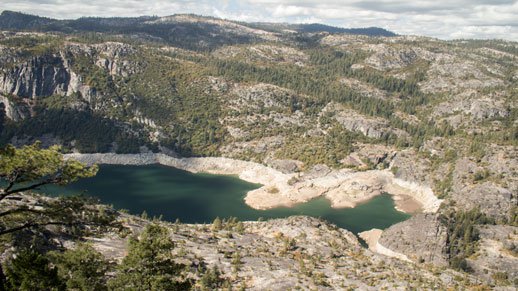Nearly 63 percent of California is currently living in areas that the United States Drought Monitor system indicates are experiencing drought conditions.
Twenty-two days into the new water year the state is better positioned in terms of reservoir storage than when the last drought started in late December of 2011. That drought officially ended in September of 2017.
The US Department of Agriculture assessment of drought conditions comes on the heels of a National Weather Service release that shows Stockton received 9.22 inches of rain or 66 percent of average and Modesto 8.17 inches of rain or 62 percent of average for the water year that ended Sept. 30. The Sierra and adjoining foothills received 75 percent or more of normal perception.
Taking other conditions into consideration, the USDA drought monitor does not list San Joaquin County, Sacramento County or most of the Sierra to be either in drought or abnormally dry conditions. That is not the case for the rest of the Central Valley including Stanislaus County or the Coastal Ranges, Cascades Range, of the Tehachapi Mountains that are considered either to be abnormally dry or in moderate drought conditions.
The Southern California coastal areas including Los Angeles and San Diego along with the Inland Empire consisting of San Bernardino and Riverside counties represent the 19.9 percent of the state that is currently classified as being in a severe drought.
Besides the 23.4 million Californians residing in drought areas, another 10.7 million live in areas currently classified as being abnormally dry. That means more than 34.2 million or 92 percent of the state’s 39.6 million people reside in areas that are currently abnormally dry or in drought conditions.
The three-month forecast model by the National Weather Service issued last week indicates there is a 44 percent chance of above normal precipitation, 33 percent for near normal and 23 percent below normal for November through December. Similar outlooks are seen as the year progresses.
The Stanislaus River watershed that South San Joaquin Irrigation District as well as the cities of Manteca, Lathrop, and Tracy relies on is currently well positioned.
New Melones Reservoir with a capacity of 2.4 million acre feet had 1,340,949 acre feet as of Friday or 132 percent of the average storage for Oct. 19. The Tri-Dam Project operated by SSJID and Oakdale Irrigation District is similarly positions with Donnells (64,320 acre feet of capacity) at 28,597 acre feet or 129 percent of average, Beardsley (97,900 acre feet of capacity) at 59,208 acre feet of 67 percent of average, and Tulloch (67,000 acre feet of capacity) at 57.714 acre feet or 101 percent of average.
In terms of current storage the Stanislaus River watershed is among the most robust in the state, a far cry from the start of the December 2011 to September 2017 drought when the central Sierra watershed that South San Joaquin County relies on was the weakest in terms of water storage.
Observations on the water year that ended Sept. 30 that were made by the National Weather Service include:
*The driest areas were located along the Coastal Range and the Central Valley, which ranged from 25-75% of normal.
*The Sierra Nevada and adjacent foothills received 75% or more of their annual average precipitation.
*For comparison, WY 2017-18 was preceded by a record-breaking WY 2016-17 for the northern Sierra,,
*The June-September period ranked as the 14th warmest on record for Downtown Sacramento, and the 25th warmest on record for Redding.
*For comparison, the summer 2018 was preceded by the warmest June-September period on record in 2017 for Downtown Sacramento, and the 2nd warmest on record for Redding.
*The 2018 average maximum temperatures were among the Top 10 for several sites including Redding, Downtown Sacramento, Blue Canyon, Stockton, and Modesto. July was among the Top 5 warmest average maximum temperatures on record for both Redding and Downtown Sacramento.
*August and September were a mixed bag of temperatures, with no record warmth experienced.
*The heat waves were generally short in duration, with the most significant occurring in July.
*The two hottest periods for Downtown Sacramento occurred July 16-19, and July 23-26.
*The hottest period in Redding was from July 14-27, where temperatures reached 100 or higher for 14 consecutive days.
*July was the third warmest on record for Redding while June 12 the 11th warmest.
*July was the fifth warmest on record for Sacramento while June was the 13th warmest.
To contact Dennis Wyatt, email dwyatt@mantecabulletin.com





